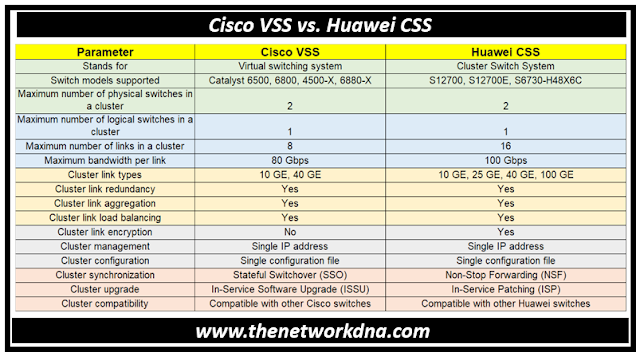Cisco VSS vs Huawei CSS: A Comprehensive Comparison
Cisco VSS vs Huawei CSS: A Comprehensive Comparison
Cisco VSS and Huawei CSS both integrate two switches into a single logical switch, however they differ in terms of features, performance, and compatibility. Lets talk about both the technologies one by one
 |
| Fig 1.1- Cisco VSS Vs Huawei CSS Technology |
⭐ What is Cisco VSS ?
The VSS technology is Cisco's proprietary network virtualization technology. Multiple Cisco switches can be virtualized into a single switch using dedicated cables, boosting the amount of ports and forwarding performance.
As you know already that in VSS, one chassis is designated as the active switch, while the other is marked as the backup switch. The active switch engine manages all control-plane tasks, such as management (SNMP, Telnet, and SSH), Layer 2 protocols (BPDUs, PDUs, and LACP), Layer 3 protocols (routing protocols), and software data.
Furthermore, VSS technology leverages inter-chassis NSF/SSO as the key high-availability mechanism between the two chassis. When a virtual switch member fails, the network does not require protocol re-convergence, and traffic is routed through access or core switches instead.
Because they only find one link failure in the EtherChannel bundle. In conventional mode, if a switch fails, several control protocols, including STP/HSRP and routing protocols, converge. In VSS mode, several devices are virtualized into a single device, decreasing the protocol's computational requirements.
⭐ What is Huawei CSS ?
Huawei CSS stands for Huawei Cluster Switch System and is a switch virtualization technology. A CSS is the combination of two clustering-capable switches into a single logical switch. CSS is a popular horizontal virtualization solution that simplifies deployment and management, expands bandwidth, and provides inter-chassis link redundancy.
- The entire CSS is managed as a switch, which simplifies O&M and lowers OPEX.
- When one device in the CSS fails, additional devices can take over control and forwarding from the CSS, avoiding single points of failure.
- Inter-device link aggregation prevents loops when the CSS is linked to other devices. Complex loop prevention procedures, such as MSTP, are not necessary.
- Inter-device link balancing guarantees full network link and bandwidth use.
- CSS simplifies networks and increases forwarding performance while preserving network functionality. The CSS system inherits all of the features of physical switches and improves their performance. CSS possesses these properties, which have led to its increasing recognition and acceptance as the ideal approach for establishing simple and efficient networks.
⭐ Cisco VSS vs Huawei CSS .. Difference
Lets talk about the comparison or difference between these two technologies Cisco VSS and Huawei CSSFig 1.2- Cisco VSS vs. Huawei CSS
- Security: Cisco ASA Vs Cisco FTD - The Network DNA
- Site-to-Site VPN: IPSEC Tunnel Between an ASA and a Cisco IOS Router
- Cisco Security: Cisco ASA 5505 Interfaces configuration for Access Ports
- Cisco Security: Cisco ASA 5505 Interfaces configuration for Trunk Port
- Cisco ASA Series 1: Restoring the ASA to Factory Default Configuration
- Cisco ASA Series 2: Configuring NAT
- Cisco ASA Series 3: Easy VPN Remote
- Cisco ASA Series 4: Configuring VLANs and Sub interfaces
- Cisco ASA Series 5: Configuring Threat Detection
- Site to Site IPSec VPN Tunnel between Cisco ASA and Palo Alto Firewalls










